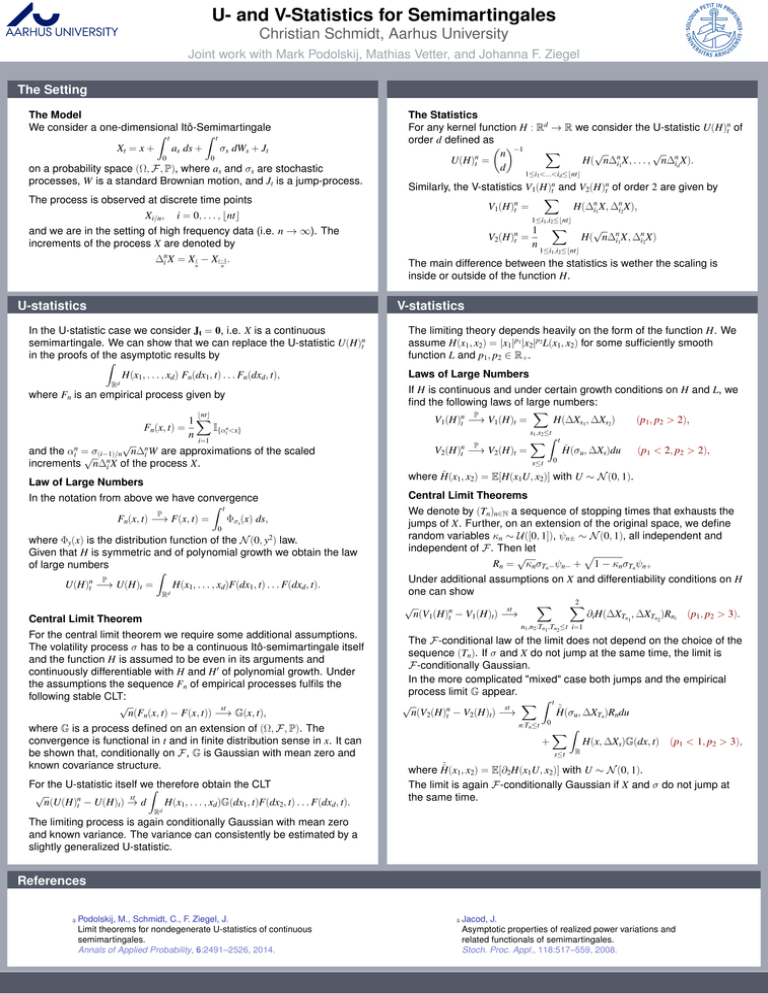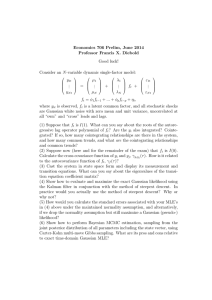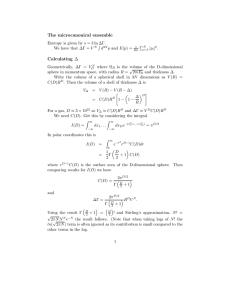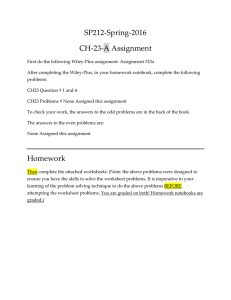U- and V-Statistics for Semimartingales Christian Schmidt, Aarhus University The Setting
advertisement

U- and V-Statistics for Semimartingales
Christian Schmidt, Aarhus University
Joint work with Mark Podolskij, Mathias Vetter, and Johanna F. Ziegel
The Setting
The Model
We consider a one-dimensional Itô-Semimartingale
Z t
Z t
Xt = x +
as ds +
σs dWs + Jt
0
0
on a probability space (Ω, F, P), where as and σs are stochastic
processes, W is a standard Brownian motion, and Jt is a jump-process.
The Statistics
For any kernel function H : Rd → R we consider the U-statistic U(H)nt of
order d defined as
−1
X
√ n
√ n
n
n
H( n∆i1X, . . . , n∆id X).
U(H)t =
d
Similarly, the V-statistics
The process is observed at discrete time points
Xi/n,
i = 0, . . . , bntc
of order 2 are given by
H(∆ni1X, ∆ni2X),
1≤i1,i2≤bntc
= X ni − X i−1 .
1
n
V2(H)t =
n
√
X
H( n∆ni1X, ∆ni2X)
1≤i1,i2≤bntc
The main difference between the statistics is wether the scaling is
inside or outside of the function H.
n
test
U-statistics
V-statistics
In the U-statistic case we consider Jt = 0, i.e. X is a continuous
semimartingale. We can show that we can replace the U-statistic U(H)nt
in the proofs of the asymptotic results by
Z
H(x1, . . . , xd ) Fn(dx1, t) . . . Fn(dxd , t),
Rd
bntc
√
The limiting theory depends heavily on the form of the function H. We
assume H(x1, x2) = |x1|p1|x2|p2L(x1, x2) for some sufficiently smooth
function L and p1, p2 ∈ R+.
Laws of Large Numbers
If H is continuous and under certain growth conditions on H and L, we
find the following laws of large numbers:
X
P
V1(H)nt −→ V1(H)t =
H(∆Xs1, ∆Xs2)
(p1, p2 > 2),
where Fn is an empirical process given by
αin
X
V1(H)nt =
and we are in the setting of high frequency data (i.e. n → ∞). The
increments of the process X are denoted by
n
∆i X
1≤i1<...<id ≤bntc
V1(H)nt and V2(H)nt
1X
Fn(x, t) =
I{αin<x}
n
s1,s2≤t
i=1
V2(H)nt
n∆niW
=√σ(i−1)/n
and the
are approximations of the scaled
increments n∆niX of the process X.
P
−→ V2(H)t =
t
Z
X
s≤t
H̃(σu, ∆Xs)du
(p1 < 2, p2 > 2),
0
where H̃(x1, x2) = E[H(x1U, x2)] with U ∼ N (0, 1).
Law of Large Numbers
Central Limit Theorems
In the notation from above we have convergence
Z t
P
Fn(x, t) −→ F(x, t) =
Φσs(x) ds,
0
2
where Φy(x) is the distribution function of the N (0, y ) law.
Given that H is symmetric and of polynomial growth we obtain the law
of large numbers
Z
n P
U(H)t −→ U(H)t =
H(x1, . . . , xd )F(dx1, t) . . . F(dxd , t).
Rd
Central Limit Theorem
For the central limit theorem we require some additional assumptions.
The volatility process σ has to be a continuous Itô-semimartingale itself
and the function H is assumed to be even in its arguments and
continuously differentiable with H and H 0 of polynomial growth. Under
the assumptions the sequence Fn of empirical processes fulfils the
following stable CLT:
√
st
n(Fn(x, t) − F(x, t)) −→ G(x, t),
where G is a process defined on an extension of (Ω, F, P). The
convergence is functional in t and in finite distribution sense in x. It can
be shown that, conditionally on F, G is Gaussian with mean zero and
known covariance structure.
For the U-statistic itself we
Z therefore obtain the CLT
√
st
n
n(U(H)t − U(H)t) → d
H(x1, . . . , xd )G(dx1, t)F(dx2, t) . . . F(dxd , t).
We denote by (Tn)n∈N a sequence of stopping times that exhausts the
jumps of X. Further, on an extension of the original space, we define
random variables κn ∼ U([0, 1]), ψn± ∼ N (0, 1), all independent and
independent of F. Then let
p
√
Rn = κnσTn−ψn− + 1 − κnσTnψn+
Under additional assumptions on X and differentiability conditions on H
one can show
2
X
X
√
st
n
n(V1(H)t − V1(H)t) −→
∂iH(∆XTn1 , ∆XTn2 )Rni (p1, p2 > 3).
n1,n2:Tn1 ,Tn2 ≤t i=1
The F-conditional law of the limit does not depend on the choice of the
sequence (Tn). If σ and X do not jump at the same time, the limit is
F-conditionally Gaussian.
In the more complicated "mixed" case both jumps and the empirical
process limit G appear.
Z t
X
√
st
˜
n
n(V2(H)t − V2(H)t) −→
H̃(σu, ∆XTn)Rndu
n:Tn≤t 0
XZ
+
H(x, ∆Xs)G(dx, t) (p1 < 1, p2 > 3),
s≤t
R
˜
where H̃(x1, x2) = E[∂2H(x1U, x2)] with U ∼ N (0, 1).
The limit is again F-conditionally Gaussian if X and σ do not jump at
the same time.
Rd
The limiting process is again conditionally Gaussian with mean zero
and known variance. The variance can consistently be estimated by a
slightly generalized U-statistic.
white
References
Podolskij, M., Schmidt, C., F. Ziegel, J.
Limit theorems for nondegenerate U-statistics of continuous
semimartingales.
Annals of Applied Probability, 6:2491–2526, 2014.
Jacod, J.
Asymptotic properties of realized power variations and
related functionals of semimartingales.
Stoch. Proc. Appl., 118:517–559, 2008.





